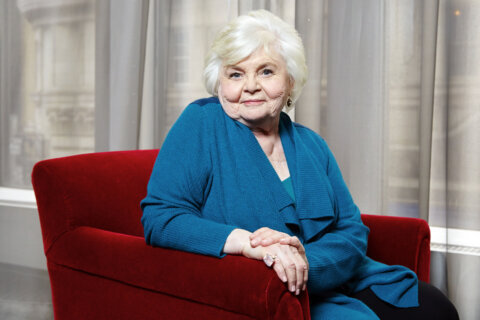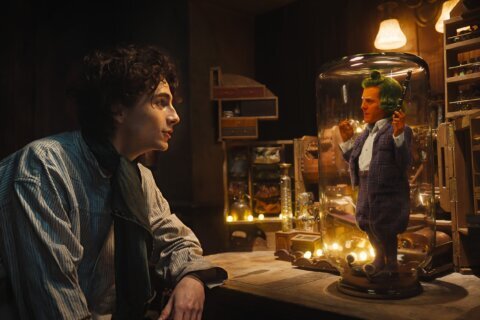Jason Fraley, WTOP film critic
WASHINGTON – The day after it won best picture for a comedy or musical at the Golden Globes, “The Artist” sold out its 7 p.m. screening at the Landmark E Street Cinema. I couldn’t help but smile. A black-and-white silent film from France had just sold out a theater in 2012 America.
If you’re still leery about watching a silent movie, don’t be. You liked the first half of “WALL-E,” right? In “The Artist,” the gimmick fits perfectly into the plot, where silent movie star George Valentin (Jean Dujardin) worries that talking pictures will ruin his career in 1927 Hollywood. His fears are compounded when his love interest, vibrant actress Peppy Miller (Berenice Bejo), finds a budding career in talkies, leaving him in a trail of stardust.
We’ve seen this story before with James Cagney in “Footlight Parade” (“It’s a fad”), Gloria Swanson in “Sunset Blvd.”(“We didn’t need dialogue; we had faces”) and Gene Kelly in “Singin’ in the Rain” (“‘The Jazz Singer,’ that’s what’s the matter”). What makes it work here is the way writer and director Michel Hazanavicius exposes the filmmaking process, creating one of cinema’s most self-reflexive works.
In one scene, he replays the same scene over and over again as the actors laugh their way through multiple takes. In another, Peppy examines a film strip and we see the action unfold one frame at a time. We become so sucked into this cinema commentary that we share in Valentin’s surprise as he sits a drink on his desk and hears a sound effect for the first time.
Not only does the silent gimmick work as self-reflexive commentary, it also forces Hazanavicius to do what so few directors understand: The art of visual storytelling. He is forced to find visual ways to express his ideas, thus providing a crash course for film language novices:
- In showing Peppy rise the showbiz ladder, we start with a close-up of her name on a film’s opening credits, then pull back to reveal it as a measly bit part. We repeat this, and each time the camera pulls out, Peppy’s name is higher on the credits, until she’s a full-fledged headliner.
- In showing Valentin’s fall from stardom, we cut to an extreme wide shot of a massive studio building, as if a cross section of a dollhouse. As workers move up and down the stairs, they pass right by Valentin, quite literally passing him by.
- Throughout that scene, Peppy stands symbolically higher than Valentin. Later, she sits high in the balcony as Valentin watches himself — and his career — sink into quicksand on screen.
- Most impressive is the use of Valentin’s suit as a status symbol. When Peppy is awed by Valentin’s stardom, she slips herself halfway into his jacket to hug herself. Later, when Valentin is forced to pawn his possessions, his reflection fills the suit on display in a store window.
The symbolic suit recalls F.W. Murnau’s silent masterpiece “The Last Laugh” (1924) — one of many classic film references. The breakfast table montage of Valentin’s gradual separation from his wife is a nod to “Citizen Kane” (1941). The tap numbers on art deco sets recall Astaire and Rogers. And a gag of identical movements on two sides of a wall stirs memories of “Duck Soup” (1933).
Of course, the most controversial reference comes during the climax, where Hazanavicius plays Bernard Herrmann’s complete “Scene d’Amour” from Hitchcock’s “Vertigo” (1958) — my favorite film score of all time and No. 12 on the AFI’s Top 25 Movie Scores. When “Vertigo” star Kim Novak heard the famous score in “The Artist,” she said she felt as though she had been raped.
I may have felt just as violated if I had not heard Novak’s charge going in. Instead, I was waiting for it as a make or break moment. Was “The Artist” a profound commentary or a cheap piggy-backer? Hazanavicius answered by playing me with a clever title card and dropping the soundtrack into complete silence, just to show the importance of a film score like Herrmann’s.
I still prefer “Sherlock Jr.” (1924), “The Purple Rose of Cairo” (1985) and “Cinema Paradiso” (1988), but “The Artist” is full of heart, charm and the best-trained dog I’ve ever seen.
With three Golden Globes under its belt for best picture, best actor in a comedy or musical, and best original score, the film has all the buzz of an Oscar contender.
If you enter with the right mindset, you’ll be both entertained by its charm and educated by its commentary. On one end of the spectrum, the public gives it an 8.5 on IMDb. On the other end, the critics give it a 97 percent on Rotten Tomatoes. Calling it from both sides of The Film Spectrum, I’m giving it 4 out of 4 stars.
For more, check out Jason’s film appreciation blog, The Film Spectrum.
(Copyright 2012 by WTOP. All Rights Reserved.)










